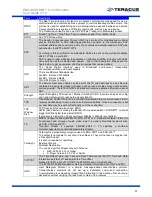
ENC-400-HDMI
™ H.264 Encoder
User Guide V1.0
35
Term
Description
DVB
The ‘Digital Video Broadcasting’ is a suite of internationally accepted open standards
for digital television. DVB standards are maintained by the DVB Project, an international
industry consortium with more than 270 members, and are published by a Joint
Technical Committee (JTC) of the European Telecommunications Standards Institute
(ETSI) mostly used are:
DVB-C
– Cable
DVB-T or DVB-T2 - Terrestrial
DVB-S or DVB-S2 - Satellite
EB_NO
The ‘energy per bit to noise power spectral density ratio’ closely related to the C/N, and
is an important parameter in digital communication or data transmission (DVB). It is a
normalized signal-to-noise ratio.
This ratio between Signal and noise should be high like 9.0 dB or better 11.0 dB
EIT
The ‘Event Information Table’ can deliver different information’s:
Present/following - actual and next TV Program
Other - event schedule information up to 30 Days
Needed for EPG, without EIT the EDID Data cannot be decoded.
The ETSI EN 300 468 standard contains detailed information about EIT
EPG
The ‘Electronic program guide’ deliver information about the running and upcoming TV
Program.
That a Decoder is able to decode EPG following Tables have to be included in the
Transport Stream:
EIT
TOT/TDT
ES
An elementary stream as defined by MPEG communication protocol is usually the
output of an audio or video encoder. ES contains only one kind of data, e.g. audio,
video or closed caption. An elementary stream is often referred to as “elementary”,
“data”, “audio”, or “video” bit streams or streams. The format of the elementary stream
depends upon the codec or data carried in the stream, but will often carry a common
header when packetized into a packetized elementary stream.
Flooding
Can be Unicast and Multicast Flooding
Multicast Flooding happen in Network environments they are not, or wrong configured.
As result a multicast is send to all Network Ports, This can be controlled with Network
Sniffer like Wireshark.
UDP Flooding is also a result of misconfigured Network Environments.
Packets sent to a Unicast IP-Address who is not available will also sent to all Network
Ports.
On most switches the configuration can be found in menu IGMP Snooping, please refer
the Switch manual.
H.264
Is a Video Codec. While the ITU-T called it H.264 the Moving Picture Experts Group
called it MPEG-4 Part 10, Advanced Video Coding (MPEG-4 AVC)
H.264 generally achieves better video quality than MPEG2 at similar bit rates.
While same quality result in around 40% lower bitrate.
H.265
Is a Video Codec. While the ITU-T called it H.265 the Moving Picture Experts Group
called it MPEG-H Part 2, High Efficiency Video Coding (HEVC),
H.265 offers again a higher data compression than H.264 or MPEG2.
While same quality result in around 40%- 50% lower bitrate.
It supports resolutions up to 8192x 4320 included 8K UHD.
HEVC
See H.265
HLS
Or also called HTTP Live streaming is an HTTP based media streaming protocol
invented by Apple Inc.
It works by breaking the overall stream into a sequence of small HTTP-based file
downloads, each download loading one short chunk of an overall potentially unbounded
transport stream.
ICMP
The Internet Control Message Protocol is part of the Internet Protocol Suite
Ping is Part of ICMP
IGMP
The Internet Group Management Protocol is a communications protocol used by hosts
and switches on Ipv4 networks to establish multicast group memberships. IGMP is an
integral part of IP multicast.
IGMP is used for one-to-many networking applications.




































